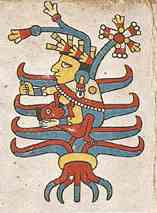|
THE CHRONICLES OF THE GÍRKŮ / Notes (3)
Genealogy
Anton Parks: In Ádam Genisiš, Gerry Zeitlin and I have charted a genealogy tree from the information to which I have had access up to today. It shows that there sometimes exist direct genetic lines between certain races and, in other cases, genetic procedures, that is to say genetic manipulations (clonage). We cannot truly speak of a single origin or race; this tableau clearly demonstrates that. But my view is limited in time; I know only the periods that relate to the personage of Sa'am (Enki-Osiris) and his posthumous son Heru (Bęl-Horus). I have then no detail on prior events, but only whatever confronted these two personalities that they subsequently encoded into Ugur, the crystal that they each carried... [N]
We provide (at right) the "genealogy chart" from Ádam Genisiš. This chart has several highly unusual features, never seen in standard genealogies, due to the nature of the information that it presents. We see individuals engendering entire races, using various combinations of their own DNA and that of other races, including some archived in a repository. Obviously not all generated beings are the result of natural couplings or even what you might call "personally-owned" DNA; in fact, most are due to pure laboratory-based genetic operations -- "cloning". We attempt to distinguish these methods through the use of color-coded lines. We also (crudely) indicate the proportion of "Abgal" DNA -- from the evolutions of Sirius -- as this inheritance generally confers a high order of being. Naturally those who do not have it might disagree. And that is a hint as to the great story that will unfold. Relative positioning on this chart is not very meaningful. However, genetic descent does run from higher to lower down the lines.
The time epoch depicted extends from indefinitely ancient through the time of arrival of renegade Gina'abul on the Earth, and on down through the Sumerian, Egyptian, and "Biblical" epochs. It depicts all of the personages and races significant to Earth development during that period. A separate graphic, found in the section
Creating Humans, shows exactly who was responsible for the stepwise unfolding of the humanoid races through the modern humans, and their complete genetic heritage.
In the vastness of time, entire species have migrated from one star system to another. This is specifically the case with the Kingú-Babbar, who relocated from Ušu (Draco), where they created the Ušumgal, to Urbar'ra (Lyra), and later some went to Te (Aquila). In the genealogy chart, locations associated with root sources or with newly-created species refer to dwelling places at the time the creation took place. Thus the Kingú-Babbar are shown associated with Ušu. In other words, the overall graphic is not a snapshot of any single point in time, but rather is a composite.
The Gina'abul have a concept of father and mother. However, as stated above, very little impregnation took place. In fact, this was banned by law. Sa'am was created by his "father" An in the laboratory. Although it was clear that An contributed some of his own genetic material to his creation, it is also clear that there was something else, and what that was, was a subject of intense interest and discovery throughout the books -- or at least as far as the third volume in the series, under development at the present time.
As illustrated in the genealogy chart, Sa'am actually incorporates genetic material from his eventual lover Mamitu-Nammu, herself partly amphibian through her Abgal heritage (see
Races).
Enlíl's genetic heritage is of interest. Sa'am had been attempting to create special Nungal having modified physiques and accomplished characters. He had succeeded in extracting the genetic information from cells of several progenitors -- from himself and Gina'abul cells possessed by Mamitu, programming and combining these to create a group of seven clones. He added equally the genetic material from the Nungal prototype that was derived from the same base from which Abzu-Abba had created the original Šutum. The ensemble of all this was finally mixed with several other genes from different Gina'abul ancestors taken from their library of genetic patrimony.
Sa'am's specimens contained almost a tenth of his person, a little like biological children.
The result was terribly disappointing. Although apparently brilliant, they were wily, canny, and undisciplined. Sa'am's genetic creations were intended to be of Kadištu grade, but these were violent and prone to assaulting the Nindigir (heavenly priestesses).
Unfortunately the seven emerged from their siensišárs (artificial wombs) while Sa'am was elsewhere, undergoing a critical
initiation. During his absence, the priestesses put to death six of the seven, but one escaped, probably with the help of a priestess who took a fancy to him. Confronting and capturing the seventh upon his return, Sa'am, seeing much of himself in this offspring, and recalling how his own life had been spared in a parallel situation, allowed him to go free.
This was, of course, the future Enlíl.
The chart provides various names assumed by the personages whose long lives extended through many epochs. For example, it is revealed in Ádam Genisiš that Sa'am is actually the famous Enki. And so we understand that Enlil should not really be considered to be the brother of Enki as we would understand the term, and as is believed by some Sumerian "enthusiasts" today.
The two do possess some genes of An.
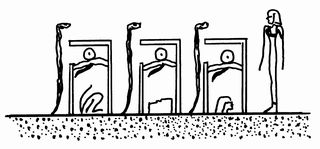
Personages
While possibly something of that sort can occur at times, an important part of Parks' depiction is the deliberate production and cultivation of myths by powerful beings and their organizations. This has barely been touched on, yet, in these unfolding pages. A bit more discussion can be found in the section on Inanna-Ištar.
Dim'mege
Dim'mege was a priestess who was also a bit of a
gourmande, which did not do much for her silhouette. Her corpulence symbolized her generosity of heart.
She possessed a tail like those of the Ušumgal. Hers dragged along constantly and carelessly on the ground.
A FAMILY Early in the Ádam Genisiš narrative, Mamitu-Nammu reveals to Dim'mege that, by the cells used in their cloning, Sa'am and Sé'et are her brother and sister, as Mam is the "mother" of all three. You can see this relationship in the "Source Races and Founders" diagram at the top of this page. Dim'mege then informs her siblings that the four of them are a family. Indeed they form a closely-knit unit from that time on. There is no one "father" to Mam's children.
Very tactile, she never ceased placing her hands on us as though to taste us and to savor each instant passed at our sides.
Her manner of speaking was always very courteous and cultivated.
Dim'mege often saturated herself with a powerful emanation with the scent of apricot. We had to evade it at times so as not to become intoxicated by her nauseating balm.
Her tastes were multiple: she wore heavy bracelets and shimmering fabrics. Silver metal scintillated on her eyelids and precious stones streamed to her neck.
HudiliHudili, my faithful Nungal, was there in the doorway. His physiognomy had changed again. He seemed still larger; it was no doubt an impression. The progressive mutation of the Nungal was completely unpredictable.
When I rejoined him, he patted me on the shoulder to encourage me. That was the first time that he made this gesture, the first of a very long series. I couldn't fail to notice that little blond hairs were beginning to push out on his head. I smiled to myself. Certain Nungal did not totally appear to be Alagní (clones) of one another.
Only the last series that I had done had received a certain treatment. I had subjected the quartz, which we generally used as receptacles for the cells, to controlled sequences of radiation doses, which had targeted influences on the genes. This technique was inscribed within me by my genitor [An]. It gave us several series of Nungal with varying individualities as well as programmed immunities. These specimens possessed autonomous genetic mutations that immunized them against most of the known viruses.
Had he shed his skin in the same manner? [See Nungal] MikaelDual VersionsThe confusion of two distinct historical personages into one jumbled tradition is important for us to understand, as it is emblematic of many such jumblings that have resulted in today's inside-out and upside-down religious conceptions. Parks has gone to lengths to untangle the two. We compress his presentation here, hoping to maintain the clarity of his ideas. This discussion is supported by the linguistic analysis found at Case 2 - MULTIPLE MEANINGS OF THE NAME "MIKAEL". Each of the two Mikaels is the head of a group of "angels" -- two opposing groups, actually. The name Mikael and variants are also associated with quite distinct personalities in various traditions.
All is in agreement when one realizes that the "Watchers" of the
Book of Enoch are the adversaries of Mikael-Ninurta in the service of
Yahvé (An and Enlil). Abzu (1)
The constant and intense radiation of the inner sun of Uraš illuminated a universe disordered in appearance. My craft overflew mountains leveled by flowing torrents...
I was overwhelmed by this discovery of such biodiversity. Uraš was as surprising in its heart as on its exterior.
In this setting dominated by a large internal ocean, I discovered an incredible number of varieties of animal and vegetable species...
My progenitor and I camped near the great cascades that fell down the mountainside opposite the mountain that overhung the capital of the Abzu, which was named
Šŕlim [Decoder]. The deafening noise of the waterfalls plunging into the ocean bathed us at our work for countless Ud (days).
The interior sun of this planet's ancient world is extremely powerful, much hotter than any that I had seen. Its light is different in its chemical and ultraviolet rays, which supports varieties of species totally unlike those of the exterior.
The sun's radiant purple-crimson cloak provides a constant temperature throughout the cavity. The abundance of coral scattered throughout all latitudes of the primary ocean indicated a hot sea. The rich calcareous secretions of the aquatic organisms of the rivers and lakes were also in keeping with the hot ambiance.
The Abzu of Uraš possesses, certainly, immense varieties of exotic terrains, but it is above all a fluvial and maritime maze which gives it the aspect of a gigantic reservoir.
Mam gave this interior sea the name Engur.
Note: The Sumerian term ENGUR was generally used to name subterranean waters as well as the abysses of the Abzu. It was equally employed to designate the primordial goddess Nammu, which is to say Mamitu, as a symbolic representation of the unique source of the primordial waters.
It is necessary to come to terms with the idea of the Abzu, a prominent feature of Mesopotamian belief systems, before going on to consider the Gina'abul Worlds, because every planet and moon in Parks' history has one.
In other words, the Abzu is a structure that contradicts our common knowledge of the Earth and all other planetary bodies in the Solar System – and seems to violate our understanding of physics as well. This little problem challenges our ability to accept Parks' report. It is not as though one could say, "I'll consider the rest but hold the Abzu, please," because activities and events taking place in the various Abzus of Parks' cosmos are so thoroughly a part of the narrative that it would be akin to saying "I can accept your description of human physiology but I just can't go with the alimentary canal."
Parks has spent much effort on this problem. In collaboration with
Hans W. Lintz, Parks provides an extensive report in the Dossier:
Les Mondes Creux on his site
Anton Parks.com. We have reviewed the portions of the report relating to the Earth and Moon (i.e., not dealing with data on other solar system planets). Briefly, we find one highly interesting nineteenth-century personal account of a fisherman and his father who sailed into the northern opening, spent 1-1/2 years with the civilization in the cavity, sailed out the southern end, and were shipwrecked there. Beyond that, the well-known and controversial story of
Admiral Byrd's adventures and dubious satellite data add little to the case for the Abzu. Yet we could not have expected more in the way of data in the public domain at this time.
Meanwhile, we can touch on some basic questions.
The first – and naive – concern would be about how gravity would work in this situation. How could you run a city in there, with people falling to the center of the Earth all the time? Doesn't gravity "point" to the center of the Earth?
The answer is: yes if you are on on or above the surface, but no if you are anywhere inside a spherical cavity concentric with the earth's outer surface. In that case -- I have not confirmed this but understand that it is simple enough to do the obvious integration showing that the force of gravity is zero throughout such a cavity. This is frequently discussed on "hollow earth" - related forums.
What has not been mentioned is the gravitational field within a large class of cavities not necessarily symmetrically placed. If you have any doubts about how gravity would work within this larger class of cavities, consider an underground parking garage, a cavity that is a member of this class. Gravity exists there. Suppose the lower floor of the garage had an opening to a tunnel that extended to or past the center of the earth, creating an irregularly-shaped aggregate space. Obviously the force of gravity would vary throughout this space.
One could imagine widening this space to form any of a large variety of shapes, where gravitational forces would be non-zero in at least in some parts of the spaces, though they might vary throughout.
Clearly there are many ways in which an inner earth cavity would support gravity. But not all possible cavities would be suitable candidates for our inner earth.
The constraints are:
It must be open to both of the Earth's poles or polar regions. It must be able to contain a small "sun". It should not result in significant gravitational or seismic anomalies at the Earth's surface (or if it does, earth scientists must be capable of misconstruing them).
Part of our difficulty in approaching these questions stems from failing to grasp the sun and the surrounding planet as a single unit, and failing to consider the process of planetary formation.
Open SETI frequently entertains the cosmological and physical theories of Dr.
Paul A. LaViolette. In particular, as described in
Open SETI Physics 101, planets are formed from the energy and particles emitted from a gravitational well where there is excess genic energy. At the point of emission, there is probably what appears to be a hot little sun.
The next phase might be an interaction between interstellar particles being attracted toward the gravitational well, and outward-moving energy and particles. Might there be a point of equilibrium at a given radius where a shell of matter would begin to form? The details of this process are not to my knowledge given in any of LaViolette's books (if they are, we will find out shortly).
What is the mechanism that stabilizes the system so that the sun does not wander around and collide with the shell? Again on our page, we mention that the
genic energy radiation pressure goes as 1/r4, which creates a strong restoring force opposing any such tendency.
Another major detail requiring an explanation would be the holes at the poles of rotation. I personally am not clear on this point, as the dynamics appears complex, but it seems reasonable that if there was rotation in the first place, that these holes might appear due to centrifugal force. Is LaViolette's planetary formation model the final word in the view of Open SETI? Actually it is not.
The
Electric Sky Model of plasma astrophysics, introduced for your convenience at the link, and its subsidiary Electric Sun, described for example in Donald Scott's The Electric Sky (2006), being scalable over the range of cosmological- to laboratory-sized dimensions, provides us with a perfectly reasonable model of a small sun that could exist in the earth's cavity. This is because stars are not fusion reactors requiring a certain size and gravitational pressure, but simple foci of plasma occurring along strung-out
Birkeland Currents.
In this model, the energy from the sun (any sun) is supplied by the Birkeland current, a plasma in "dark current mode" (i.e, in the low-current-density regime in which it is not emitting light).
The Birkeland current feeding a planet's inner sun would very definitely have to pass through polar openings.
Is it possible that those openings are a part of the geometry of a "recombination zone" that is responsible for planetary formation itself?
The reader will surely ask, "How can it be that all planetary bodies are hollow with openings at their poles, and we have not seen this in the images from our interplanetary probes?"
The unspoken question: "Are we to believe that the data have been withheld from us, and if so, why? Why go to all that trouble? What is the point?"
Parks' reasoning is as follows:
To confirm that all planets are hollow would be to admit that the Earth is equally so. To recognize that this planet is hollow, with a habitable interior, implies that one must make an accounting of possible other populations, and undertake expeditions to the center, but that is at the moment completely impossible. Why? Because, according to numerous legends of the Earth and in accord with the traditions of Tibet, the Eskimos, and even the Hopi Indians of Arizona, the interior of the Earth is occupied by a civilization of a highly developed intelligence, affiliated -- for some of them directly, and for others indirectly -- with the "Celestial Bestiary!" Most of our readers have heard of these legends. For many of us, our response has had to be to afford them a measured level of credibility, as though to say we respect those peoples who hold these myths and say these things, but not to face the implications. The reason is that the complete break from the common worldview that would be required, the end of the SCAM, seems to present an imposing prospect, if not absolutely frightening. But for others, it's a way of life.
For concepts of the Abzu in the ancient world, click
here.
ŠŕlimThe City of Eternity
On the ground, paving stones of chalcedony ran between walls of white marble. Palms and mimosas bordered the streets, exhaling light, fleeting scents. Time seemed never to have passed through the four portals of the sacred city...The emphasis on the final phrase is mine. An odd thing for Parks to say, one would think. We are used to thinking of the Earth as our solar system's center of life and culture. But that was not true in Sa'am's day. That center would have been Mulge, a planet that was later destroyed. Šŕlim Images: Glimpses of Work in ProgressIt will eventually be possible to provide readers with detailed images of Šŕlim, since Parks has these clearly in mind.The process of rendering them for viewing on this page has been very slow, however, as attention has had be given to many levels: terrain, major construction, city plan, buildings, vegetation (gardens, ornamental trees, etc.), vehicles, lighting, and inhabitants. Some of these layers are beginning to take form now, and while crude and unfinished, some of our working images are approaching a level that can perhaps be shown, if readers will be a little forgiving. Our purpose in showing images even at this early stage is to help readers begin to feel a sense of the reality of this place, not only as it once was, but as it perhaps might still be... though this needs much discussion and clarification.
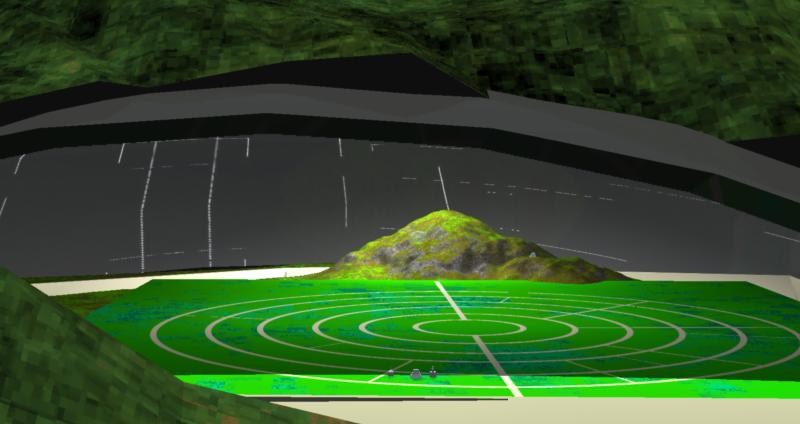
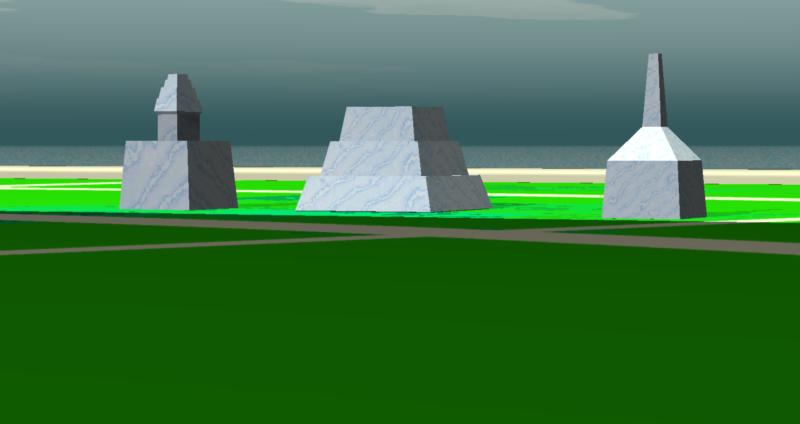
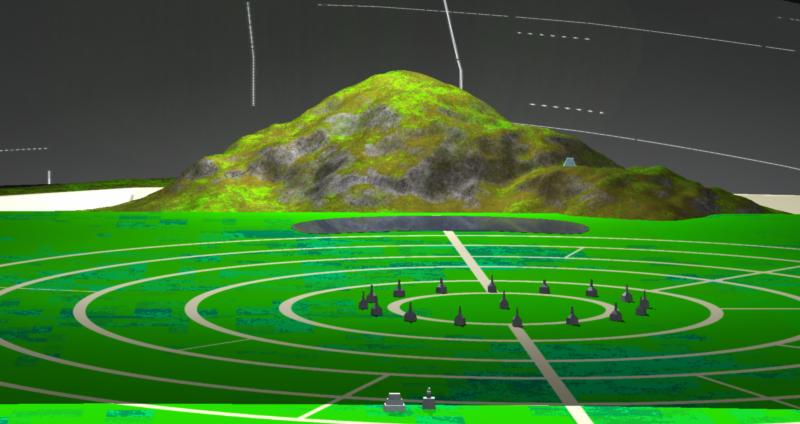
WorldsConstellations as we define them are not experienced by the Gina'abul. Anton Parks, tapping into Sa'am's memory, recalls awareness of "mother stars" (i.e., stars with life on one or more of their planets) and various groupings of stars before his arrival in our solar system. Once on the Earth, he could easily recognize the mother stars within the constellations as seen from here.
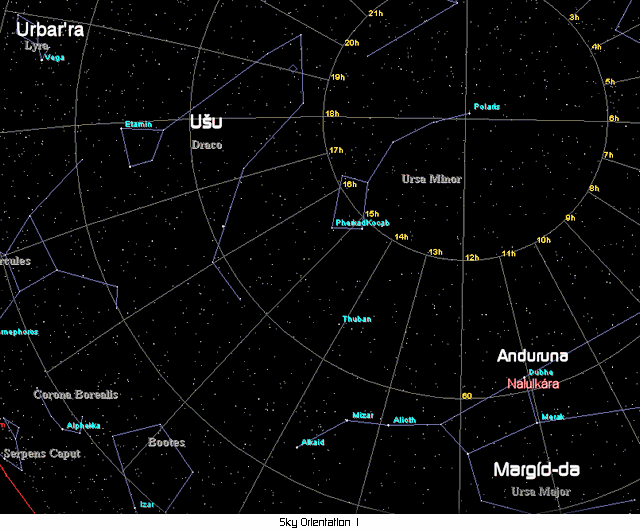
Also known as alpha Ursae Majoris, Dubhe is a yellow giant, about 25 times the size of the Sun, and located 86 light years from here. Dubhe is a "close visual binary." The Uanna, monumental mothership of the Gina'abul lord An, is reported by Parks to have been – at the opening of his narrative – situated on the "night side" of Nalulkára. This implies a synchronized rotation or "resonance" of Nalulkára with respect to Andaruna/Dubhe, similar to that of our moon with the Earth.
As of this writing, March 9 2006, no planet corresponding to Parks' giant Nalulkára has been detected.
Parks also "saw" (as Sa'am, in his initial flight made on the first day of his life!) entire cities of thousands of Amašutum near the "southern" extremity of Nalulkára.
The royal city of Nalulkára is named Unulahgal.
The city of Ankida was where the complete genetic patrimony (as frozen cells) of the Ušumgal was stored.
Beyond the Amašutum cities is the opening into the "Abzu of Nalulkára," named for the old father/king Abzu-Abba. Not the most beautiful in the Anduruna system, but the most vast of all the planets possessed by the Gina'abul, and those on which they had set foot up to that time.
Also seen in Sky Orientation 1 is Ušu (corresponding to our Draco), the "birthplace of the Gina'abul" Urbar'ra (Lyra) is the birthplace of the Miminu (Greys), who were created there by the ancestors of the Ušumgal (see Races) with the assistance of the Mušgir, who contributed their genetic patrimony.
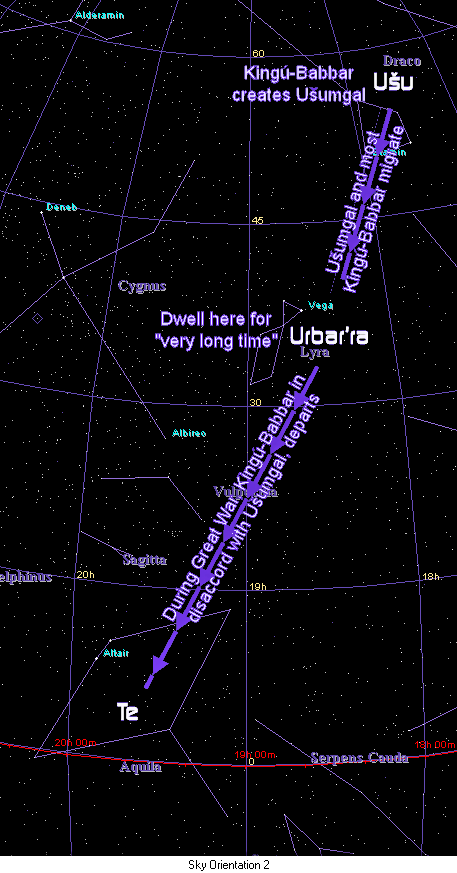 Sky Orientation 2 again shows Ušu (the Dragon) and Urbar'ra in the northern sky, and also includes Te (Aquila) near the celestial equator. Migrations of the Ušumgal and Kingú-Babbar races are depicted here. The Kingú-Babbar had been in conflict with Mušgir and later with Ušumgal when they were all located together in the Ubar'ra constellation. Some Kingú-Babbar then returned to their original home in Ušu, while others migrated to Te, and later settled in our solar system, under an exceptional accord with the Kadištu. These figure prominently in the history told in Ádam Genisiš. Keep in mind that all of these views are projections looking outward from the solar system. What were historically defined as constellations are actually associations that can be quite extended in the radial direction, and this is the case with the constellations depicted here. Radial distances within these star groups can be larger than the lateral separations of the groups themselves. For a better perception of this, examine the image Solar Neighborhood to 50 ly below.  (Click image for 3D closeup)
The very important planet Duků is the place where the Ušumgal created and trained the Anunna, an activity that precipitated the war that drove them all to Tiamate, our solar system. (We will have much more to say about this.) Duků is in the system of Ubšu'ukkinna (Maia), one of the bright blue-white stars in the group known to the Gina'abul as Mulmul (the Pleiades star cluster).
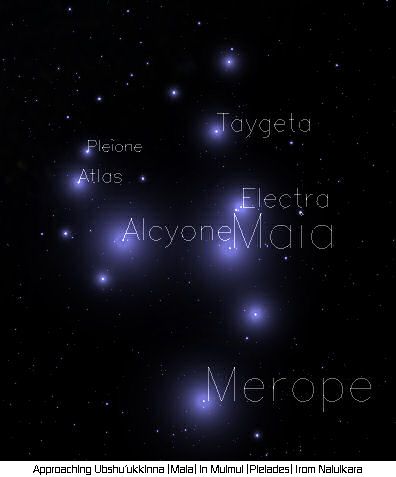 Two other planets of Ubšu'ukkinna (Maia) on which significant events take place in Parks' narrative are Éšárra and Ébabbar. Sa'am witnessed military training activities on these worlds. According to Parks' memory, the Ubšu'ukkinna system has 12 planets altogether. See Decoder for a decomposition of the name Ubšu'ukkinna. This was also the name of the sacred place of assembly in each large Mesopotamian city.
The Hopi indians of Arizona call the celestial Ubšu'ukkinna Toonaotakha, which they translate as "the Confederation of Planets." It refers to a celestial region of 12 planets where dwell the Kachinas, the spiritual guides of the Hopi traditions (see Joseph Blumrich's transcription of White Bear's teachings, KASSKARA UND DIE SIEBEN WELTEN). The Toonaotakha stellar system is precisely situated in the Pleiades, named by the Hopis "Seven Sisters."Blumrich's work with White Bear is covered extensively by Anton Parks on Parks' page ATLANTIS CONTRE MU, found on Anton Parks.com. Kásskara is identified with the ancient Mu; Talawaitichqua with Atlantis. We have also indicated a planet named "Adala" (Sumerian ADA-LA, "the song of happiness") that according to Parks seems to exist in the Taygete system.
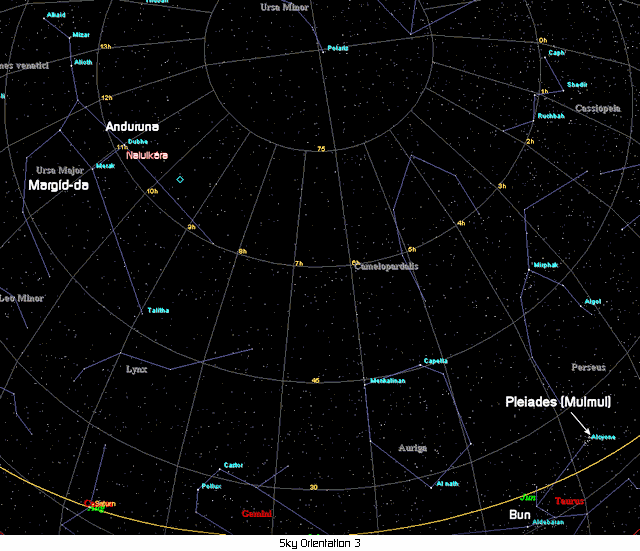 Farther south in Sky Orientation 4, Gagsisá (Sirius) is the source of the (amphibian) genetic material used by Tiamata in the creation of Mamitu-Nammu... and through her, inherited by Sa'am. Both Mamitu-Nammu and Sa'am have slightly webbed hands. All of this will be found to be important with respect to Dogon legends. Gagsisá is considered to be one of the most important bases of the Life Designers confederation, an "admirable place." Although it appears close to Gagsisá from our perspective, the constellation Sipazianna (Orion) consists mostly of stars ten times farther away, and dispersed over a large volume of space. Numerous Gina'abul colonies are found in the region, strongly allied and mixed with humanoid beings native to the area. Together they have created a hybrid race. These peoples multiply themselves via sexual reproduction.
Sipazianna (Orion) is the original home of
the Urmah (see
Races).
In Parks' narrative, a newly-created line of Amašutum was obliged by the Ušumgal to abandon its home in the Ubšu-ukkinna system and relocate to Gišda after the Great War.
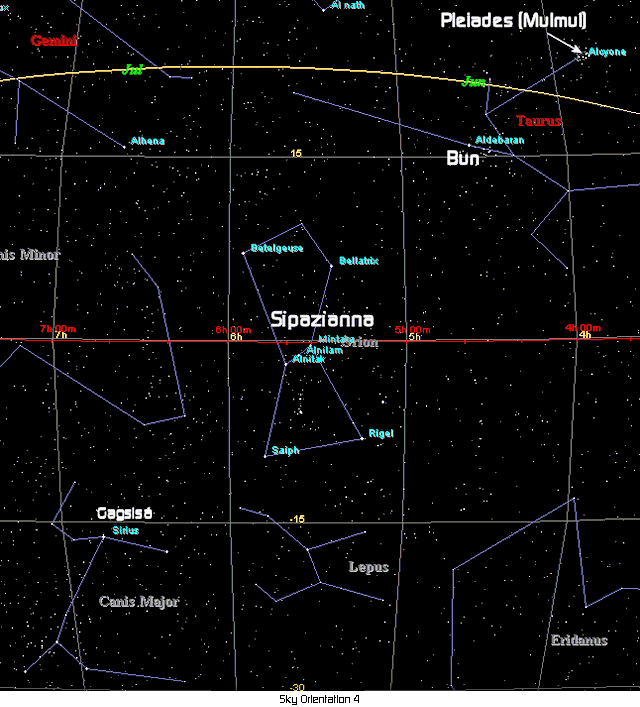 The following graphic helps to visualize the important Gina'abul locations in three-dimensional reference to our solar system (Tiamate). It is based on a map of the brightest stars in the solar neighborhood out to 50 light years. Where Parks names specific stars that fall within this radius, these are circled and labeled. Where only constellations are identified, any stars on the map that belong to those constellations are indicated. Some constellations extend beyond the boundary of the map, and one (Ubšu-ukinna) lies far beyond the border, at 440 l.y. Anduruna, while it appears in the Ursa Major constellation (which is largely included in the map), is actually not part of it, and lies 124 l.y. from here.
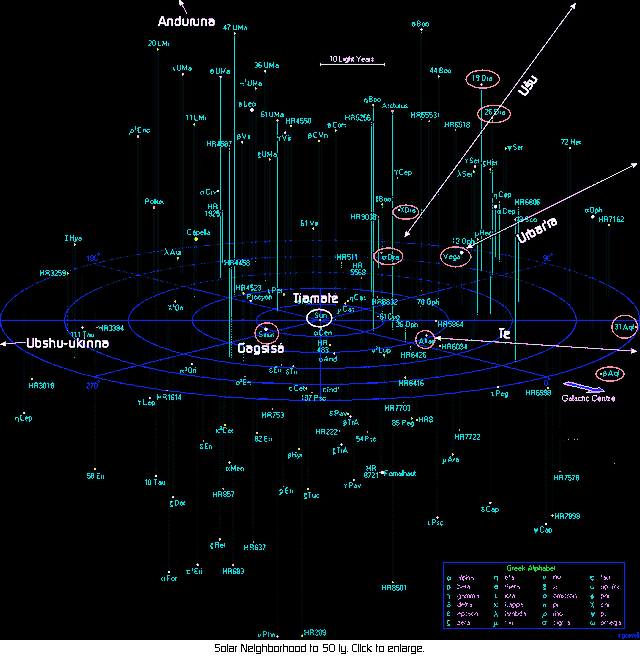
Situated at the intersection of numerous galactic routes, Tiamate (the solar system) was named by the Kadištu in homage to the Gina'abul queen Tiamata, who had done so much for peace and for this celestial region. In Gina'abul, Ti-ama-te evokes "the place where compassion and life intersect" because there existed here an experimental sphere in which innumerable forms of life cohabited. This was Uraš (the Earth), the major center of the Gina'abul universe. Uraš (the Earth) is a place of duality where the notions of good and evil are experimented on with vehemence. This carries no judgment.Shortly after their arrival on Uraš, Sé'et explains to Sa'am that our satellite Itud -- the moon -- is an artificial planetary body, completely hollow, with its own Abzu (subterranean world). It was a secret base, concealing a small group of priestesses, but mainly occupied by Imdugud, who are fair-skinned Kingú, descendents of the famous Kingú-Babbar (albino Kingús). One final note: Parks refers to a planet named Mulge that existed in the solar system at the time of his Secret narrative. In his own words: Mulge ("the black star") is the holy planet of the Amašutum and the Kadištu in the system of Ti-ama-te (the solar system) and also the ancient planet that evolved between Mars and Jupiter. Mulge rotated in the opposite sense with respect to the other planets and was placed as a frontier, subdividing toward the downstream, that is to say toward the sun, the four warm planets (Mercury, Earth, Mars, as well as Venus -- which, at this ancient epoch, was the moon of Mulge), and on the other side, toward the exterior, the colder planets such as Jupiter, Saturn, etc.
See
TI-AMA-TE
Diranna - StargatesThe important Gina'abul centers known to Parks are scattered over distances of several hundred light years. One wonders how the Gina'abul manages such a far-flung society, and whether distance itself has any importance to them. In their endless wars, is the proximity of star systems a factor? Consider our experience here on this planet, in which "spheres of influence" lost their geometric meaning once we mastered the art of high-speed intercontinental travel. The Gina'abul have apparently done this on their scale, but how did they do it? According to Parks, stargates - the Gina'abul word is Diranna - are the key.
These famous ports have always been primary for beings mastering the techniques of space travel. Each planet possesses very numerous Diranna. As for the Gina'abul, it was more or less customary to construct our larger centers where the Diranna were more densely clustered.Note: The Iníuma and Gigirlah (known to the males as Margíd'da) incorporated inertia-neutralizing technology. Another class of vessel, the Mú-u, exposed its occupants to the full effects of acceleration, like our own craft of today, and were not intended for travel through Dirannas. These were for point-to-point operations on planetary surfaces or for trips between the surface and orbiting platforms. The term Mú-u is an extension of the Sumerian MU, meaning name. In fact, according to Parks, the words for name in Sumerian, Akkadian, Hebrew, and Egyptian can all be treated as containing this silent doubled vowel, because in the fabrication of words in human languages from the Emešŕ, doubled vowels were always compressed to one. See Case 1: "NAME" = SHORT-RANGE SPACECRAFT on the Decoder page for clarification of how this was accomplished in these four languages.
 Illustration of two jet aircraft or shuttles of the Mú-u class, extracted from a photograph of a rock near Oraibi, Arizona, by White Bear. The engraving is ancient; prior to the invention of aircraft. Note between the two objects the strange silhouette of something resembling a satellite.Departure through a Stargate After having precisely calculated our destination, we stretched out on deep seats in order to relax. The automatic calculations being tedious, it was only after taking roughly a quarter Danna (half hour) of our patience that we suddenly felt our craft vibrate feebly; from the exterior it must have resembled a light humming.This particular flight from Nalulkára to Duků (see Worlds) took approximately 90 "days" as sensed by the travelers, and arrived at Duků's main stargate in the otherwise unremarkable town of Adhal. One other very important point about stargates: in addition to their function of facilitating travel over long distances in space, they are interdimensional passages, launching ramps to other planes of reality. When the stargates are closed to travel on the KI (i.e., Earth's 3rd dimension), they are closed to all dimensions. This means that since Earth's stargates are closed, the Kadištu who evolved on higher dimensions have great difficulty visiting the KI here. It is sometimes possible for them to do so in the vicinity of stargates because in the immediate surroundings of the Diranna, space-time is not exactly as we normally perceive it.
SoulsParks explores the metaphysics of the soul throughout his books. In a key encounter with Anšár (in Le Secret), Sa'am finds the Kuku apparently engaged in creating souls, and Sa'am is shocked by this. He protests, stating his understanding that only the Original Source has that function. Once created, Sa'am believes, the soul expresses as a self in a being, and then commences a series of experimental incarnations (Zišŕgáls) each expressing a fragment of the original soul in an evolutionary reincarnational process (Gibilzišŕgál). Anšár derides this notion, indicating that Sa'am was created as a one and only perfect soul. And Anšár ought to know, as he had created Sa'am's creator An. Anšár goes on to say that Sa'am sounds very much like Mamitu-Nammu, who had once espoused the principle of reincarnation (Gibilzišŕgál) in a memorable impassioned testimony to the entire Gina'abul. They had not been impressed. But Tigeme (Tiamata) had permitted Mamitu-Nammu to go to work and presumably develop her ideas if she wished, on the "accursed Uraš", which is to say the planet Earth. Anšár almost taunts Sa'am by reminding him that no matter how much he might wish to deprecate such "self will", he is actually the very model of it, having been created thus by An and himself. But obviously, Anšár says, the "inscrutable cult of the Kadištu" has not had the best of influences on him. Much is going on here, as this passage speaks not only of conflicting metaphysical systems, but of a methodology of total control practiced by the Ušumgal, as Sa'am is informed that everything he has ever done and ever will do has been programmed, and that nothing and no person can break that control. Was he to be proven correct? This is a central theme in the book, and in our own world. In the Karmapolis [K1] interview, Alain Gossens asked Parks to speak about the souls who incarnated on the Earth at the time of the Gina'abul colonization, and to explain the purpose of the Gina'abul in this. With the arrival of the Gina'abul, this place has become a zone of free "judgment." Many consider that it is a stroke of fortune to be able to incarnate on the Earth today because the instruction here is intensive and altogether unaccustomed.Parks also mentions that the Gina'abul are incarnating beings, just as we are, and that certain humans can easily incarnate among them, and they among us. There are no particular rules about this, other than the evolution of species through karmic laws, which most of the Gina'abul males still have not absorbed.
DivinitiesFrom the Karmapolis [K1] interview (slightly edited): In the Gnostic cosmology, Sophia is an Aeon, a cosmic divinity, who was part of an ensemble known as the divinities of the Pleroma.1Parks traces the evolution of concepts of the "Mother Goddess" and masculine deities in the literature of human societies. We quote here (with a little editing) from his Note 22, pp. 118-119, Le Secret. In diverse passages of the Judaic literature but also of the Bible and other traditions of the planet, "the original primordial and androgyny source" has been subtly replaced by a masculine divinity named God or The Father.
|
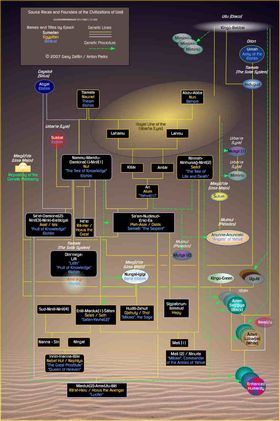
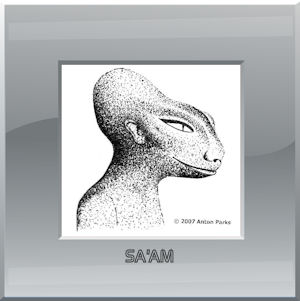
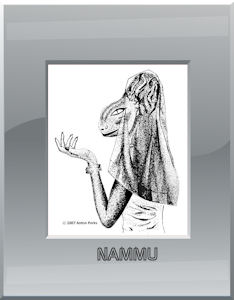
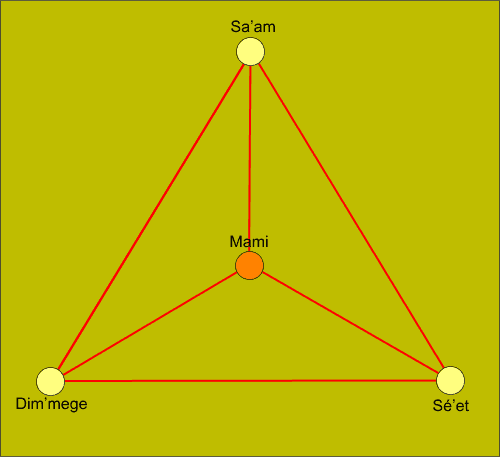
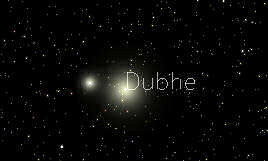 Parks mentions a short night on Nalulkára due to a second nearby star. In fact, Dubhe B is catalogued. At present, a
Parks mentions a short night on Nalulkára due to a second nearby star. In fact, Dubhe B is catalogued. At present, a
